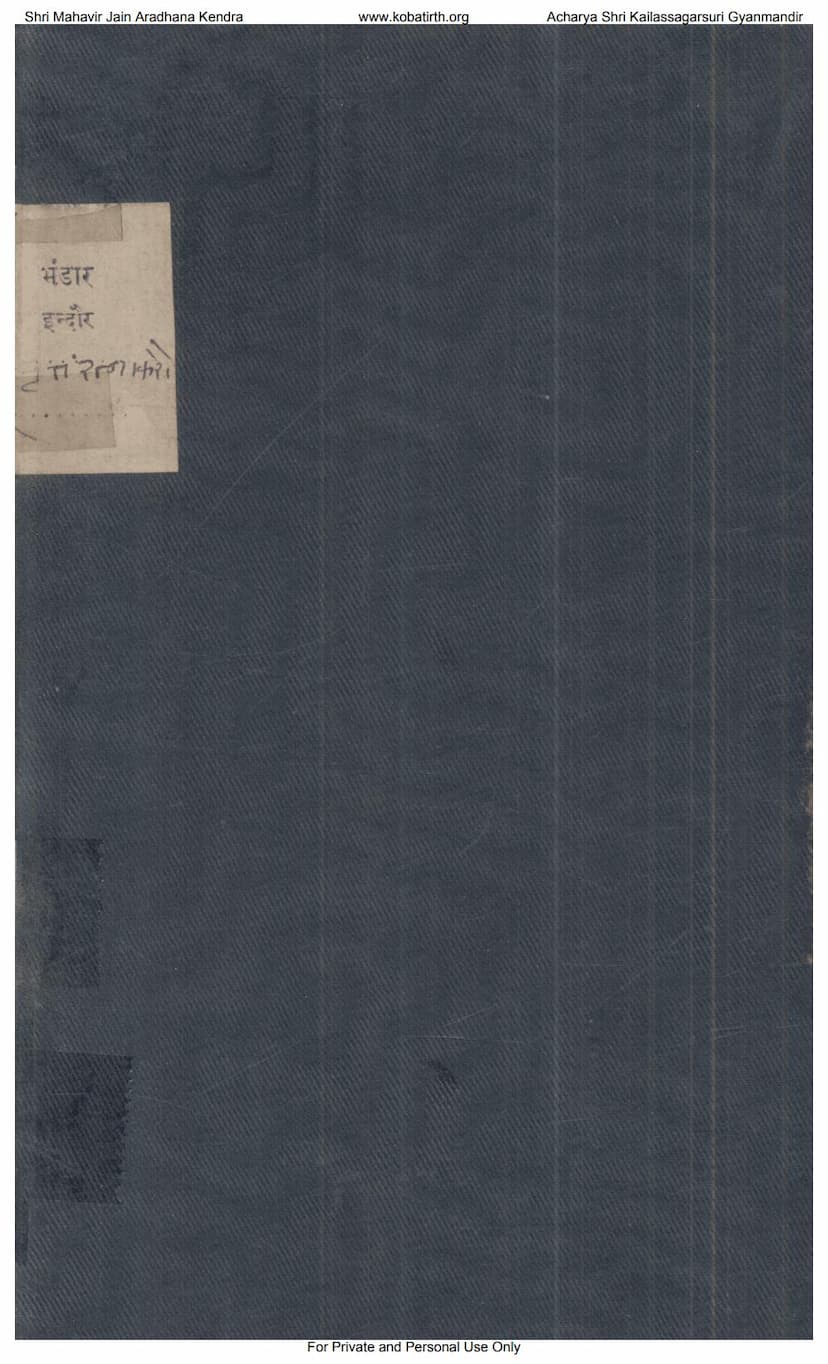Shrutbodh Vrittartankrou Granthou
Added to library: September 2, 2025

Summary
Here's a comprehensive summary of the provided Jain text, "Shrutbodh Vrittartankrou Granthou" (meaning "Shrutbodh and Vrittartankara") by Khemraj Krushnadas:
Overall Purpose and Content:
The text is a compilation of two significant Sanskrit works on prosody (the study of poetic meters): Shrutbodh and Vrittartankara. These works aim to systematically explain the rules and characteristics of various poetic meters (chandas) used in Indian literature, including Sanskrit. The book provides definitions, classifications, and examples of these meters, making it a foundational text for understanding poetic structure.
Key Components and Structure:
The provided pages reveal the following:
-
Title and Authorship: The title "Shrutbodh - Vrittartankau Granthau" clearly indicates the two main texts contained within. The author is identified as Khemraj Krushnadas, who is also the publisher.
-
Publisher and Publication Details: The book was published by Khemraj Krushnadas in Mumbai at their "Shri Venkateshwar" (Steam) Press. The publication date is given as Samvat 1958 (Vikram era), corresponding to Shak 1823, which translates to 1902 AD.
-
Introductory Pages:
- The initial pages (1-3) are dedicated to the Shri Mahavir Jain Aradhana Kendra and Acharya Shri Kailassagarsuri Gyanmandir, highlighting their role in preserving and disseminating Jain literature. They express gratitude and blessings from various respected Acharyas.
- Page 4 explicitly states the title and the publisher's details, confirming Khemraj Krushnadas's role in printing the works of Kalidas and Bhattkedar.
-
List of Books: Page 5 and 6 present a "Brief list of purchased books" from the publisher. This list includes various poetic and grammatical works, indicating the publisher's extensive catalog. Notably, "Shrutbodh Vrittartankara Sateek" and "Shrutbodh Sanvay Bhasha Teeka" (Shrutbodh with Sanskrit commentary and Marathi translation) are listed under "Chhandogranthah" (Works on Metre). This confirms that the current text is indeed an edition of these metrical works. Other books listed are primarily classical Sanskrit poetry and grammar.
-
Content of Shrutbodh (from Page 7 onwards):
- The text begins with the Shrutbodh section, starting with an invocation to the divine and gurus.
- The author of the commentary (Teeka) is implicitly Khemraj Krushnadas.
- The verses of Shrutbodh define fundamental principles of prosody:
- Definition of an Akshara (Syllable): Page 7 explains what constitutes a "guru" (long/heavy) syllable, including those that are long, nasalized, aspirated, or at the end of a line.
- Ganas (Metrical Feet): Page 8 details the concept of "Ganas" (groups of syllables like 'ma', 'ga', 'sa', etc.) and their classification as "guru" (heavy) or "laghu" (light). It also touches upon the astrological and auspicious implications of different ganas.
- Various Metres (Chandas): The subsequent pages (8-26) systematically define and explain numerous poetic meters. Each meter is described by:
- Number of syllables per pada (line/quarter verse).
- The position of 'guru' (long) and 'laghu' (short) syllables within each pada, often described using ganas.
- The location of 'yati' (caesura or pause) within the line.
- The name of the meter (e.g., Arya, Giti, Upagiti, Sharadoola Vikriditam, Malini, etc.).
- The text frequently quotes or references "Ratnakara," suggesting a connection to or reliance on the "Vrittaratnakara" for definitions.
- Gana Table: Page 27 provides a table listing the names of the ganas, their structure (e.g., 'sss', '।।।'), their associated deities, and their perceived fruits (positive or negative effects).
-
Content of Vrittartankara (from Page 27 onwards):
- The text transitions to the Vrittartankara, again beginning with an invocation.
- Author of Vrittartankara: The text explicitly mentions that Kedara is the author of Vrittartankara, who was the son of Pavyeka, a learned Brahmin. Kedara wrote this work for the easy understanding of children who have not studied prosody extensively.
- Structure of Vrittartankara:
- It is presented as a "target-and-definition" (lakshya-lakshana) work, meaning it provides both the rules (lakshana) and examples (lakshya) of meters.
- It follows the structure of Pingala's Chhandah Shastra, discussing both "matra" (morae-based) and "varna" (syllable-based) meters.
- The work is divided into six chapters, with the pramana (measure or extent) of the prosody being 136.
- It explains the concept of "aksharas" (syllables) and their constituent parts, forming the basis for the eight classes of ganas.
- The text then systematically defines various meters, similar to Shrutbodh, detailing their structure, syllable count, and pauses. It covers meters from one syllable to more complex ones.
- The latter part of Vrittartankara details the "pratyayas" (means or methods) for analyzing meters: Prastar (enumeration of all possible combinations), Nashtam (finding a particular combination based on its position), Uddishta (finding the position of a given combination), Ek-Dvi-Adi Lag Kriya (operations for counting syllables), Sankhya (number), and Adhvāyoga (path analysis). These are presented as tools for metrical analysis.
Significance and Context:
- Jain Connection: While the works themselves are classical Sanskrit prosody texts, their publication by Khemraj Krushnadas under the auspices of the Shri Mahavir Jain Aradhana Kendra suggests a recognition of their importance within Jain scholarly circles or for Jain literature that might employ Sanskrit meters.
- Educational Value: The compilation aims to be an accessible guide to prosody. The commentary (Teeka) makes complex rules understandable, especially for those new to the subject.
- Historical Value: The 1902 publication date places it within a period of significant revival and printing of traditional Indian texts. The publisher, Khemraj Krushnadas, was a prominent figure in this movement.
In essence, the book "Shrutbodh Vrittartankrou Granthou" serves as a vital resource for understanding the intricate science of Indian poetic meters, presenting two seminal works with commentary for the benefit of students and scholars.